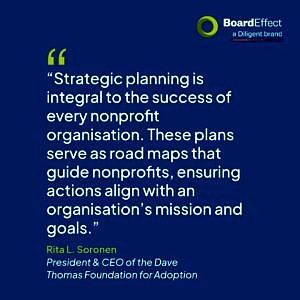
The board’s role in developing a strategy plan for a charity
Picture this: a charity standing at the crossroads of potential and purpose, where every decision carries the weight of transforming lives and communities. At the heart of this endeavour is the board, a group of dedicated individuals tasked with charting the course to success. The key to unlocking this potential lies in strategic planning — a critical, albeit challenging, process that demands insight, foresight and a commitment to the mission.
As the world rapidly changes, charity and nonprofit boards must navigate these waters with a solid strategic plan — a roadmap — for ensuring they not only meet the demands of today but also anticipate the needs of tomorrow. With the right tools and mindset, boards can create a powerful strategy that aligns with their mission, empowers their members and serves their communities.
However, charities and not-for-profits vary in size, purpose, function and reach. Because of this diversity, strategic planning cannot be a one-size-fits-all process. Directors need to consider the uniqueness of their boards when beginning the planning process.
For example, some boards turn to strategic planning committees to lead the process. Boards may also need to rely on past strategic plans as a starting point for writing new plans, or they can seek examples from similar organizations.
What are the benefits of strategic planning?
Mission-driven boards often approach the strategic planning process with enthusiasm, yet they fail to monitor their plans throughout the year and may miss valuable benefits. Best practice is to view the planning and implementation process as more than a formality. A thoughtful approach to developing a strategic plan yields many benefits:
- Fosters year-round strategic thinking
- Encourages board training and development
- Inspires new activities
- Improves decision-making
- Enhances community networks
- Creates growth opportunities for directors, staff and volunteers
- Improves overall effectiveness and responsiveness to community needs
As Rita L. Soronen, President & CEO of the Dave Thomas Foundation for Adoption, points out in a Forbes article on the topic, “Strategic planning is integral to the success of every nonprofit organisation. These plans serve as road maps that guide nonprofits, ensuring actions align with an organisation’s mission and goals.”

How should boards do strategic planning?
Boards should look at strategic planning as a proven way to position the organization for success and mission-fulfillment. A strategic plan defines key goals, determines who will take the lead on various activities, and explains how to implement and monitor those actions.
After the plan has been written and approved, it is vital that it be monitored and implemented across the organisation. This helps to ensure that everyone, including leadership, staff and volunteers are aligned and working together.
Free strategic plan template for charities and nonprofits
For your strategic planning, we have created a free customisable strategic plan template to help strengthen decision-making, ensure alignment with mission and goals, and improving organisational efficiency. Download the template to use it for your next planning session.
How to approach the strategic planning process
While the strategic planning process may seem daunting, it does not need to be. Boards can approach this important responsibility with confidence by taking these first steps:
- Review the organisation’s mission, vision and values before working on the strategic plan.
- Evaluate earlier strategic plans, if available, to gauge progress towards goals. Determine if any unmet goals should be added to the new strategy.
- Engage in a SWOT process (strengths, weaknesses, opportunities and threats).
- Establish goals using SMART standards (specific, measurable, achievable, relevant, time-bound).
With reasonable SMART goals in place, you are ready to create the strategic plan for how your board will achieve those goals and who will be responsible for monitoring progress throughout the year. The written plan should also include a schedule for completing each goal and for quarterly reviews to assess plan effectiveness.
How BoardEffect supports the strategic planning process
Critical to a nonprofit board’s strategic planning process is confidentiality, access to important board documents and security. BoardEffect’s board management solution provides a safe and accessible environment for directors to collaborate and communicate about the strategy process.
In this HBR article, the author explains that nonprofit boards need to keep strategy front and center in everything they do. Board agendas – at least quarterly – should include time for reviewing strategic plans and monitoring progress. BoardEffect’s software for building and revising agendas with customisable templates gives administrators flexibility to update agendas for this and other purposes.
Additional BoardEffect features, such as the document library and user dashboards allow authorised board members to find historic data and progress reports anytime, from any device. Secure workrooms also provide online locations for directors to hold committee meetings, discuss issues and participate in special activities.
Charity and nonprofit boards can achieve their goals and fulfill their organisation’s mission with the help of an effective and well-written strategic plan. BoardEffect is an essential tool to support directors as they engage in this important strategy planning process. Request a demo today to find how we can help.







